
Haydock Place
Endeavour Cottage in Whitby located in the courtyard of Haydock Place.
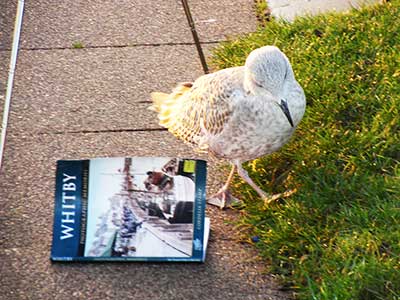
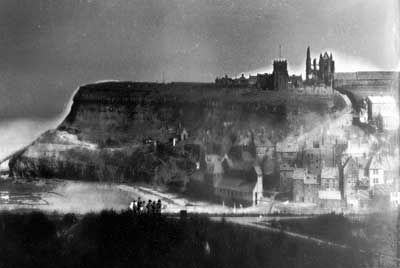
A nice way to approach Whitby is from Pickering coming over the North York Moors, a beautiful 22 mile drive through some of the most scenic rugged moorlands. If you are lucky enough to drive over the moors in late July or early September you can see a spectacular purple coating of heather which is beautiful.
I would recommend, before going into Whitby, taking a short detour from the main road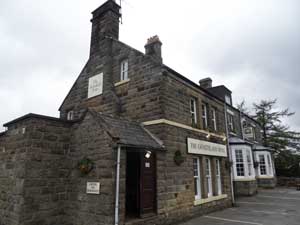 cutting over the moors and visiting Goathland, a very scenic village. The village became a major tourist attraction in 1991 when it became the setting for the long-running television series called Heartbeat, with the village being used as the fictitious Aidensfield village. The hotel in the village became the Aidensfield Arms named after Saint Aiden, with the local garage opposite the hotel becoming the fictitious Scripps garage and funeral directors.
cutting over the moors and visiting Goathland, a very scenic village. The village became a major tourist attraction in 1991 when it became the setting for the long-running television series called Heartbeat, with the village being used as the fictitious Aidensfield village. The hotel in the village became the Aidensfield Arms named after Saint Aiden, with the local garage opposite the hotel becoming the fictitious Scripps garage and funeral directors.
The film above is a guide through Whitby in HD. If you would like to use the film on your website you can do all we ask is that you give as a link back in return using the words Whitby Cottages linking to www.endeavourcottage.co.uk
The North York Moors Railway is one of the biggest attractions in the area, which still runs steam trains for tourists. It was originally commissioned in the 1830s providing a link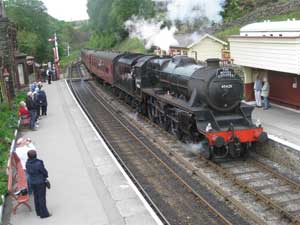 between Pickering and Whitby. The station at Goathland was used in the Harry Potter films, with its traditional old exterior it was perfect for the setting called Hogsmeade Station in the film. In 1965 the station was closed but three years later in 1968 the North York Moors Historic Railway Trust, helped by many volunteers from the group, began to operate the railway between Pickering and Grosmont and the first service was commissioned in 1973.
between Pickering and Whitby. The station at Goathland was used in the Harry Potter films, with its traditional old exterior it was perfect for the setting called Hogsmeade Station in the film. In 1965 the station was closed but three years later in 1968 the North York Moors Historic Railway Trust, helped by many volunteers from the group, began to operate the railway between Pickering and Grosmont and the first service was commissioned in 1973.
On leaving Goathland it is a short ride into Whitby of about four miles and as soon as you climb up the hill away from the Goathland Village you are greeted by the panoramic view of Whitby harbour dominated by Whitby Abbey on the skyline.
Filmed HD Walking Tours of Whitby - Robin Hoods Bay - Staithes - Sandsend and Runswick Bay
Tweet - FB Like Us or G + Us..
For starting a walking tour of Whitby we shall begin by parking in the North Cliff car park which is just behind the Royal Crescent. whitby.html
Leave the car park and turn into the Royal Crescent, which was built by George Hudson,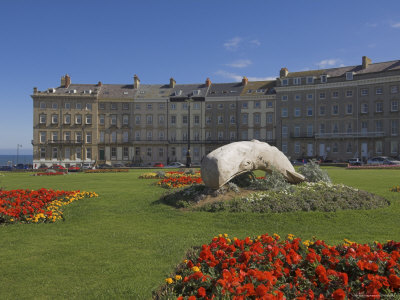 with its imposing large semicircle of terraced properties, all facing the old and now the newly rebuilt next door Whitby Spa, used for exhibitions, dancing, amateur dramatics and many kinds of popular artistic events and exhibitions.
with its imposing large semicircle of terraced properties, all facing the old and now the newly rebuilt next door Whitby Spa, used for exhibitions, dancing, amateur dramatics and many kinds of popular artistic events and exhibitions.
Walk past the Spa and you are greeted by probably the most spectacular view in Whitby in front of the Royal Hotel. There is the famous whalebone jaw which dominates the skyline along with the statuette of the famous explorer Captain James Cook. From this vantage point there is a beautiful view of the River Esk flowing out to sea dividing Whitby into North and East sides. The river is spanned by the old Whitby 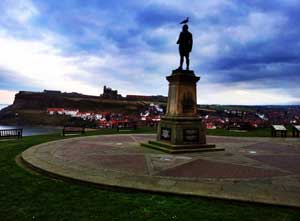 Bridge built in 1909.
Bridge built in 1909.
If you look over to the opposite side of the River Esk on the east side, you get a fine view of Church Street winding its way through the old town towards the famous 199 steps which lead up to St Mary's Church and Whitby Abbey.
Leaving this vantage point we will now go down towards the harbour area by descending the stone steps which lead you towards the middle section of the Khyber Pass. Then continue to wind down the road towards the bandstand on Pier Road, which becomes the focal point for the dancers and musicians during Folk Week each year. Folk Week is after what is generally thought to be the main event ie the Whitby Regatta.
Opposite the bandstand th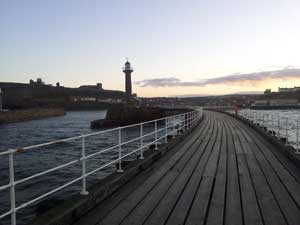 ere is the old Whitby lifeboat museum and gift shop which was originally built in 1895 to house the local lifeboat, but this was decommissioned in 1957 and became a museum for tourists.
ere is the old Whitby lifeboat museum and gift shop which was originally built in 1895 to house the local lifeboat, but this was decommissioned in 1957 and became a museum for tourists.
From the bandstand you are at the very beginning of the main pier on which tourists can stroll, gaining wonderful views down towards Sandsend and breathing in the brisk sea air.
The twin east and west piers of Whitby were in existence before the 1500s, but it was not until 1540 that they became structured from Oak and these then were replaced partially with stone during the reign of King Charles 1. In 1735 they were then completely rebuilt in stone with the West Pier being extended again to reach its length of 309 metres in 1814.
Follow Us Please.
You then have no choice but to double back. If you look towards the right you will see a large curved stone wall with cafeterias at the top and this area is called The Battery. It has two very old round stone houses at either end which were originally used for storing of ship fuel.
Now walking back down towards the town, you pass an area which is probably not the most historic (being the amusement arcade) but still a welcome sight for people with children. If you are feeling hungry there are several takeaway fish and chip shops along Pier Road.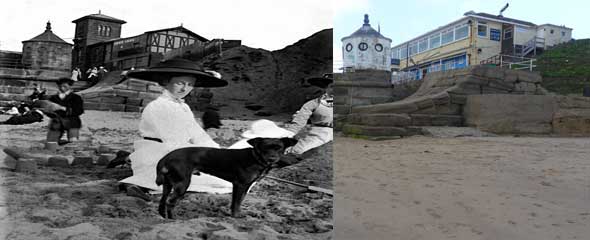
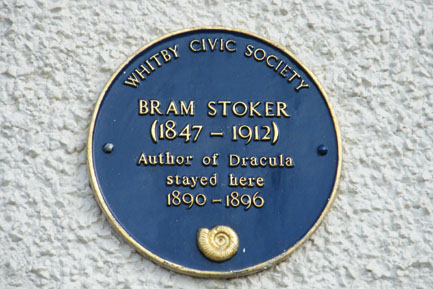 A little further along you will pass the museum dedicated to Bram Stoker's Dracula. The bestselling book was written by the author while he was staying in Whitby, with the town’s scenery being the inspiration for his bestselling book Dracula. The Count, was said to have been shipwrecked on Tate Hill sands, along with a large black dog, from the ship called The Demeter. Bram Stoker was inspired by the Abbey to write this world famous gothic tale while he was staying on the Royal Crescent.
A little further along you will pass the museum dedicated to Bram Stoker's Dracula. The bestselling book was written by the author while he was staying in Whitby, with the town’s scenery being the inspiration for his bestselling book Dracula. The Count, was said to have been shipwrecked on Tate Hill sands, along with a large black dog, from the ship called The Demeter. Bram Stoker was inspired by the Abbey to write this world famous gothic tale while he was staying on the Royal Crescent.
During the summer, along the length of Pier Road there are several boats which will take you out on sea trips, there is even a speedboat if you fancy a thrilling ride down towards Sandsend. The most authentic boat is the old Whitby lifeboat called Mary Ann Hepworth which was first 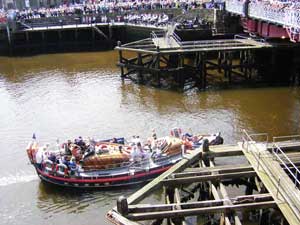 launched in 1939. It is now run by a very friendly gentleman called Barry, who was a crewman of the Whitby lifeboat, and he brought the old boat back to Whitby. He has managed to restore the boat, as near as possible to its original condition, and he obtained a licence to conduct pleasure trips in 1989. The boat has featured in several television programmes including ‘Heartbeat’, TV series ‘One Summer in Whitby’ and ‘An Island Race’ with John McCarthy. There are even longer sea trips on some of the other boats which, at the right time of the year, can take you whale watching .
launched in 1939. It is now run by a very friendly gentleman called Barry, who was a crewman of the Whitby lifeboat, and he brought the old boat back to Whitby. He has managed to restore the boat, as near as possible to its original condition, and he obtained a licence to conduct pleasure trips in 1989. The boat has featured in several television programmes including ‘Heartbeat’, TV series ‘One Summer in Whitby’ and ‘An Island Race’ with John McCarthy. There are even longer sea trips on some of the other boats which, at the right time of the year, can take you whale watching .
Next we come alongside Whitby Bridge, but we shall return to this spot a little while after we have detoured to take in more of Whitby.
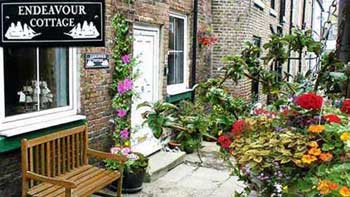
Turning up the steep hill to the right of the bridge you come to the base of the street called Flowergate, which was mentioned as far back as 1220 on several local documents. It has also been called High Street by Whitby locals. The street now has many shops and little yards to the left and to the right which housed many Whitby cottages like Endeavour Holiday Cottage. As the shops on Flowergate end, you are now on St Hilda's Terrace with the big terraced properties on the right-hand side and with Whitby Park on the left-hand side. www.endeavourcottage.co.uk
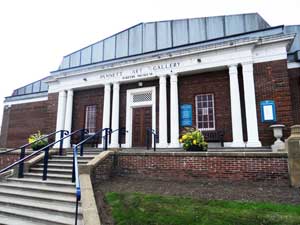 Pannett Park has wonderful gardens and lovely views over the town. Situated at the top end of the Park there is an art gallery and Whitby’s main museum. Inside the museum there are many of Whitby’s historical artefacts, like Bronze Age weapons and Roman lamps. There is also a large collection of fossils and an extensive collection of items connected to Captain Cook, the famous explorer from Whitby, and his many voyages dating between 1768 and 1779. There is also the best collection of Whitby jet artefacts in the world. The Museum, library and archives are taken care of by the Whitby Literary and Philosophical Society, which dates back to 1823. It was started by a collection of local citizens and its leader the Rev George Young, who was the author of the History of Whitby 1819, which became a classic. The main objective of the society is to organise and maintain the museum which was run by the people for the people of Whitby.
Pannett Park has wonderful gardens and lovely views over the town. Situated at the top end of the Park there is an art gallery and Whitby’s main museum. Inside the museum there are many of Whitby’s historical artefacts, like Bronze Age weapons and Roman lamps. There is also a large collection of fossils and an extensive collection of items connected to Captain Cook, the famous explorer from Whitby, and his many voyages dating between 1768 and 1779. There is also the best collection of Whitby jet artefacts in the world. The Museum, library and archives are taken care of by the Whitby Literary and Philosophical Society, which dates back to 1823. It was started by a collection of local citizens and its leader the Rev George Young, who was the author of the History of Whitby 1819, which became a classic. The main objective of the society is to organise and maintain the museum which was run by the people for the people of Whitby.
From Whitby's museum you can wind your way down through the park and head towards Baxtergate, which is not only one of the main shopping streets in Whitby but also one of the most historic streets, originally going back to 1400. It was named after a family called Baxter who owned property around this area. Probably one of the prettiest old yards is Linskill Square which once a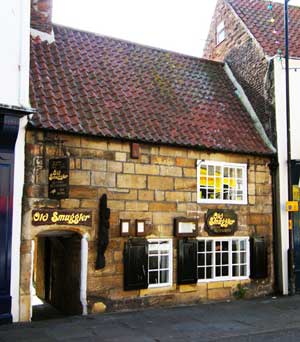 gain now occupies many holiday cottages which face each other with a cobbled yard area.
gain now occupies many holiday cottages which face each other with a cobbled yard area.
This part of Whitby has buildings representing a style of older Whitby, including the Old Ship Inn, a very old building rumoured to have had a secret passageway which took you down to the harbour front. There is a figure on the front "Ye old smugglers“ which is very likely to be a relic of some old wreck. To the side there is a little passageway which has one of the most memorable names of any of the yards in Whitby, being called Loggerhead yard. People like to have their photograph taken at the front of this unusual name.
Baxtergate originally was completely residential until around 1700 and it is actually built on a sandbank with an old mooring post being discovered in the past during excavation. In the first part of the 19th century there was an iron foundry and an old Quay which belonged to Mr George Chapman who was buried under an iron cast tombstone in the old churchyard. Also currently you could find a clay pipe maker here by the name of Richard Hilton. In the middle of Baxtergate you 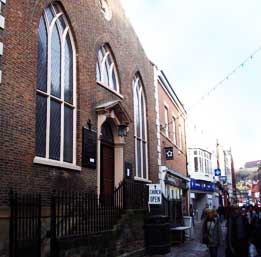 see stone steps leading up to St Ninians Church, opened in 1788, which was constructed by shipwrights to welcome several thousand visitors a year through the doors. Baxtergate is very popular nowadays because it is accessible on the flat from Whitby’s bridge and is a very busy prominently shopping area which runs parallel to the harbour and gives access to the main tourist information centre and various cafes and eateries.
see stone steps leading up to St Ninians Church, opened in 1788, which was constructed by shipwrights to welcome several thousand visitors a year through the doors. Baxtergate is very popular nowadays because it is accessible on the flat from Whitby’s bridge and is a very busy prominently shopping area which runs parallel to the harbour and gives access to the main tourist information centre and various cafes and eateries.
As you leave Baxtergate you are faced with the famous Whitby Swing Bridge again spanning both East and West sides of the old town.
On August 8th 2009, Whitby Bridge celebrated its centenary and I was lucky enough to attend the event myself with a fine public turnout on the day including the Lord Mayors of Whitby and Scarborough. The photographs of the original bridge opening ceremony from 1909 show similar crowd scenes to the ones which were there at its centenary, including pictures of the cutting of the ribbon ceremony to officially open the bridge. The structure of the bridge was built by the same company that built the Blackpool Tower. There were two special centenary plaques placed at either end of the bridge, featuring three paintings by John Freeman, Whitby's local artist. The actual centenary day of the bridge was 23 August 2009. Full story here Whitby Bridge Centenary
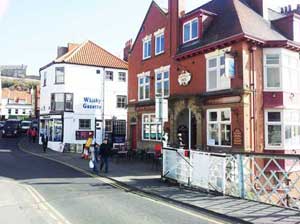 On crossing over the bridge to the east side, looking to the right, you can see the Whitby Gazette building at the entrance of Grape Lane, originally named Grope Lane because it was the place where the local prostitutes found their business.
On crossing over the bridge to the east side, looking to the right, you can see the Whitby Gazette building at the entrance of Grape Lane, originally named Grope Lane because it was the place where the local prostitutes found their business.
Wandering down Grape Lane on the right-hand side you come across the Captain Cook Museum, an excellent place to spend a few hours looking at the original artwork and including letters which were signed by the great man himself. James Cook was born on 27 October 1728 near Middlesbrough in Yorkshire. His father was a farm worker and aged about 17, Cook moved to the coast, living in Whitby and working with a coal merchant. In 1755 Cook enlisted in the Royal Navy, and learned various skills like the ability to survey and chart Coastal waters. Cook's most famous ship was called the Endeavour, which departed Plymouth, England, on 26 August 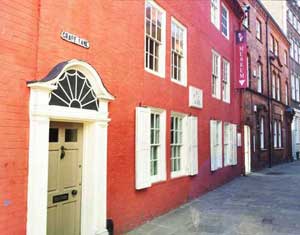 1768 on Cook's sea voyage to observe the transit of Venus from the vantage point of Tahiti. During this trip Cook also managed to circumnavigate New Zealand and the eastern coast of Australia. Also the ships called Discovery and Resolution were both connected to the captain and his sea adventures. In 2005 the museum, representing one of the finest small tourist attractions, won the Yorkshire Tourist Board’s prestigious White Rose award.
1768 on Cook's sea voyage to observe the transit of Venus from the vantage point of Tahiti. During this trip Cook also managed to circumnavigate New Zealand and the eastern coast of Australia. Also the ships called Discovery and Resolution were both connected to the captain and his sea adventures. In 2005 the museum, representing one of the finest small tourist attractions, won the Yorkshire Tourist Board’s prestigious White Rose award.
At the end of Grape Lane turning left you pass a cafe called Humble Pie which serves excellent food on tin plates because it has been redesigned recently with the decor of the 1940s.
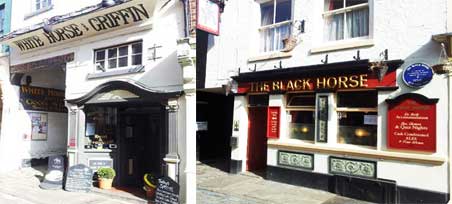 Walking along the cobbled Church street itself, you very shortly pass two historic pubs, the first one being the Whitehorse and Griffin public house, followed shortly by the Black Horse public house, one of the oldest buildings in Whitby and associated with smuggling which was very prominent in the past. Seemingly the custom and excise officers at the time were poorly paid and it is said that soldiers were sent in to try to stop smugglers, but they were unsuccessful. The Black Horse pub is said to have strong associations with many secret passageways and hiding places being used within the building.
Walking along the cobbled Church street itself, you very shortly pass two historic pubs, the first one being the Whitehorse and Griffin public house, followed shortly by the Black Horse public house, one of the oldest buildings in Whitby and associated with smuggling which was very prominent in the past. Seemingly the custom and excise officers at the time were poorly paid and it is said that soldiers were sent in to try to stop smugglers, but they were unsuccessful. The Black Horse pub is said to have strong associations with many secret passageways and hiding places being used within the building.
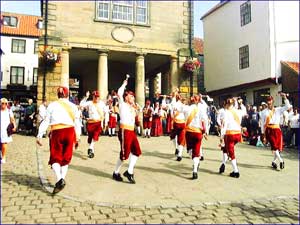
The next location is the old marketplace which dates back to the 1640s.
It has the building with the clock tower and quite regularly there is a farmers market held with various stalls exhibiting goods. Around this area there are many shops and cafes making it a popular spot. At the bottom there is an indoor market with a mixture of craft and clothes shops and just to the side there is the Shambles giving access to the Whitby Friendship Amateur Rowing Club, who launch their boats during low tide. Whitby's marketplace was not always just a place of trade, it also had a sinister past. During this time Sir Hugh Cholmley had instigated the demolition of the ancient Tollbooth which was situated in the potato market, but the new one was erected in the new marketplace. The marketplace of today is not the same one but was built later by Nathanial Cholmley in 1788, with the chosen architect and designer being Jonathan Pickernell, who had also been the engineer of the Whitby twin piers.
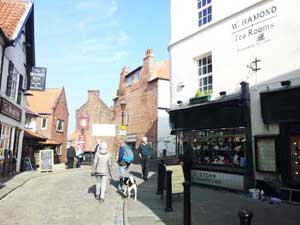 Continuing along Church Street there are many little cottages dating back to the 1600s, most of which have now been turned into shops. Several of them sell traditional Whitby jet which became highly fashionable after Queen Victoria wore Whitby jet whilst in mourning for Prince Albert, who died in 1861. The jet itself can be collected at certain points along Whitby’s beach, where you can find a particular mineral formed thousands of years ago, being the fossilised remains of the monkey puzzle trees. There is the Whitby Jet Centre, which exhibits a traditional workshop, which had been found sealed in the roof space of one old house in Whitby. Near the end of Church Street it narrows down passing the Boar Inn and The Duke of York public houses, which both serve food and provide a fine view of the harbour.
Continuing along Church Street there are many little cottages dating back to the 1600s, most of which have now been turned into shops. Several of them sell traditional Whitby jet which became highly fashionable after Queen Victoria wore Whitby jet whilst in mourning for Prince Albert, who died in 1861. The jet itself can be collected at certain points along Whitby’s beach, where you can find a particular mineral formed thousands of years ago, being the fossilised remains of the monkey puzzle trees. There is the Whitby Jet Centre, which exhibits a traditional workshop, which had been found sealed in the roof space of one old house in Whitby. Near the end of Church Street it narrows down passing the Boar Inn and The Duke of York public houses, which both serve food and provide a fine view of the harbour.
We are now at the foot of the famous 199 steps which represent the very end of Church Street, but we should detour past the steps and go along Henrie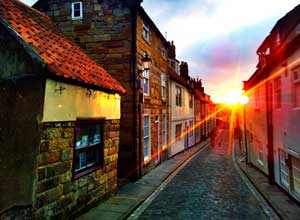 tta Street. In years gone by the street was much longer and had upwards of 1,000 residents but there was a landslide in 1787 and, with a succession of landslips, it reduced the street to its present shorter length. At the end there are some cottages which lean dramatically and have been shored up by newer buildings built over recent years in a traditional l style, with fine views across the harbour. There is a very cute cottage style building which is the famous Fortunes Kipper house and which dates back to 1822.
tta Street. In years gone by the street was much longer and had upwards of 1,000 residents but there was a landslide in 1787 and, with a succession of landslips, it reduced the street to its present shorter length. At the end there are some cottages which lean dramatically and have been shored up by newer buildings built over recent years in a traditional l style, with fine views across the harbour. There is a very cute cottage style building which is the famous Fortunes Kipper house and which dates back to 1822.
On most days you will still see smoke billowing from its roof and in fact it has been stated that quite often tourists ring the Fire Brigade thinking the building is on fire and, unfortunately, they have 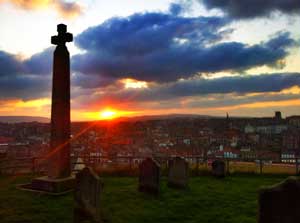 to guide their fire engine carefully through the narrow streets just in case there is a real fire, but to date there never has been!
to guide their fire engine carefully through the narrow streets just in case there is a real fire, but to date there never has been!
Doubling back it's time to ascend the 199 steps which take you up to probably the biggest tourist attraction of Whitby, which is the St Mary's Church graveyard with Whitby Abbey in the background, both dominating the skyline.
At the very top of the 199 steps the first thing you see is the tall Caedmons Cross which was carved from Northumberland stone in the style of Celtic carving. It was erected in 1898 in dedication to Ceadmon a lowly herdsman, encouraged by St Hilda.
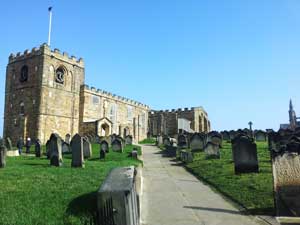 St Mary's Church was originally constructed around the 1100s, with only remnants of the original structure of the tower being evident. It was originally erected for the general population because they were not allowed to use the Abbey. Inside there are various styles of architecture from over the ages, but taking central position is the famous three tier pulpit with two ear trumpets protruding from the top tier leading to a nearby seat which were used by the vicar's wife, who was profoundly deaf and could not hear her husband’s sermons.
St Mary's Church was originally constructed around the 1100s, with only remnants of the original structure of the tower being evident. It was originally erected for the general population because they were not allowed to use the Abbey. Inside there are various styles of architecture from over the ages, but taking central position is the famous three tier pulpit with two ear trumpets protruding from the top tier leading to a nearby seat which were used by the vicar's wife, who was profoundly deaf and could not hear her husband’s sermons.
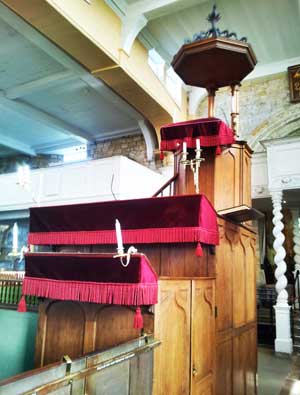 There is the Norman Chancel arch which is close to the Cholmley Pew pointing towards the pulpit, where the family of the same name listened to the sermons from the privacy of their own pew. Along the church there are various aisles and boxed pews which were owned by rich families and various groups. You can still see the names on the sides. The church has one of the finest collections of pre-Victorian furniture as well as an Elizabethan altar table. Surrounding the church itself there are many graves and tombstones which have been heavily weathered by the strong salt-encrusted winds from the sea. Many of these tombstones are in memory of the local seafaring population and lifeboat men.
There is the Norman Chancel arch which is close to the Cholmley Pew pointing towards the pulpit, where the family of the same name listened to the sermons from the privacy of their own pew. Along the church there are various aisles and boxed pews which were owned by rich families and various groups. You can still see the names on the sides. The church has one of the finest collections of pre-Victorian furniture as well as an Elizabethan altar table. Surrounding the church itself there are many graves and tombstones which have been heavily weathered by the strong salt-encrusted winds from the sea. Many of these tombstones are in memory of the local seafaring population and lifeboat men.
It's only a very short walk through the graveyard of St Mary's to Whitby Abbey, from where you can go into the tourist centre and buy tickets to view the Abbey itself and the museum.
The Abbey has a wealth of history but there is not a great deal known about the original structure which would have been a wooden church built at the top of the East Cliff in A.D.656. During the Roman period it is likely that a lighthouse was also situated there, 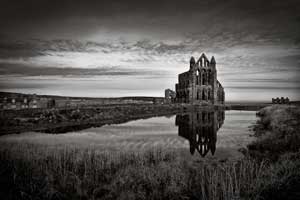 causing a Saxon name of Streonshalh (lighthouse bay). It is thought there could have been a Roman settlement at this location but the only pointer in that direction was the fact that two coins were found, close to the area where the Roman roads would have been located. The abbey was founded by St Hilda until her death in the year of A.D. 680. She was undoubtedly thought of as a very well-respected and knowledgeable woman by many of the various Kings. St Hilda was an extremely interesting woman, very wise and knowledgeable and indeed she inspired the humble herdsman Caedmon to write a song in which she appeared in his dreams, which turned out to become a famous poem. Whitby Abbey was used for the Synod of Whitby in A.D. 664 by the King Oswiu of Northumbria, for calculating the date of Easter in line with Rome's customs.
causing a Saxon name of Streonshalh (lighthouse bay). It is thought there could have been a Roman settlement at this location but the only pointer in that direction was the fact that two coins were found, close to the area where the Roman roads would have been located. The abbey was founded by St Hilda until her death in the year of A.D. 680. She was undoubtedly thought of as a very well-respected and knowledgeable woman by many of the various Kings. St Hilda was an extremely interesting woman, very wise and knowledgeable and indeed she inspired the humble herdsman Caedmon to write a song in which she appeared in his dreams, which turned out to become a famous poem. Whitby Abbey was used for the Synod of Whitby in A.D. 664 by the King Oswiu of Northumbria, for calculating the date of Easter in line with Rome's customs.
St Hilda according to legend drove snakes over the cliffs causing them to turn into stone like fossils called Ammonites, in fact called hildoceras after St. Hilda. The snakes’ heads were later carved into Ammonites and became souvenirs and indeed there are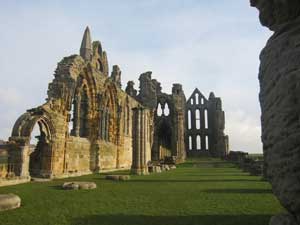 three samples on the Whitby town plaque. In later years, after St Hilda's death, the wooden structured monastery was replaced by a stone structured building, but this was eventually also destroyed by the Danes in A.D. 866. The structure was then left derelict for two centuries until the present structure, we now know as the Abbey, started in 1078 on land which was given by Reinfrid, who was a Knight. It was at this period in time that the town took its present name of Whitby (white-town). Henry VIII started the Reformation with the Dissolution of the Monasteries, which caused it to be destroyed again in 1539. What was left of the building then stood for over 200 years until 1711, when the south transept collapsed. The nave fell in 1794, followed in 1830 by the central tower disintegrating, with storms damaging the choir section in 1839. The Germans on December 14, 1914 shelled the building. The English Heritage Society is responsible for the building nowadays. Alongside the Abbey there is the 'Cholmley' family mansion built after Henry VIII's Dissolution of the Monasteries. It is situated beyond the original facade of this building, built in 1672. Today you can see the visitor centre, which is an award-winning tourist attraction, with many artefacts from Anglo-Saxon and the mediaeval period.
three samples on the Whitby town plaque. In later years, after St Hilda's death, the wooden structured monastery was replaced by a stone structured building, but this was eventually also destroyed by the Danes in A.D. 866. The structure was then left derelict for two centuries until the present structure, we now know as the Abbey, started in 1078 on land which was given by Reinfrid, who was a Knight. It was at this period in time that the town took its present name of Whitby (white-town). Henry VIII started the Reformation with the Dissolution of the Monasteries, which caused it to be destroyed again in 1539. What was left of the building then stood for over 200 years until 1711, when the south transept collapsed. The nave fell in 1794, followed in 1830 by the central tower disintegrating, with storms damaging the choir section in 1839. The Germans on December 14, 1914 shelled the building. The English Heritage Society is responsible for the building nowadays. Alongside the Abbey there is the 'Cholmley' family mansion built after Henry VIII's Dissolution of the Monasteries. It is situated beyond the original facade of this building, built in 1672. Today you can see the visitor centre, which is an award-winning tourist attraction, with many artefacts from Anglo-Saxon and the mediaeval period.
That ends our walking tour of Whitby and some of its main tourist attractions, but please come back because this website shall continue to focus on other aspects of Whitby's colourful history.
Written by Alan Davidson for Endeavour Cottages Letting Agency
Contact Alan Davidson owner and authour alan@endeavourcottage.co.uk
Would you like more bookings for your Whitby holiday accommodation? Well why don't you list your property on this website, there is no contract, you can take your listing off whenever you wish. Contact sales@endeavourcottage.co.uk
Whitby Panoramas 360° tours of some of the main beauty spots in the town
Back to Whitby History -Back to Whitby Blog

Endeavour Cottage in Whitby located in the courtyard of Haydock Place.

Across the rooftops of Whitby towards the abbey

A view of Whitby Abbey from a cottage window.

We could provide high occupancy.
Want more booking for your holiday accommodation?
List your property with us. no contract red tape, no setup fee. Just bookings if and when you want them.
Whitby Holiday Cottages Letting Agency.